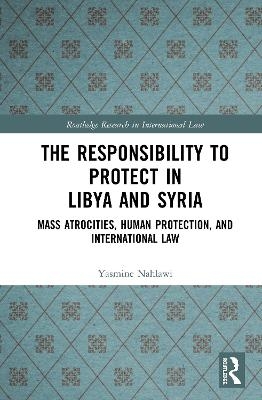
The Responsibility to Protect in Libya and Syria
Routledge (Verlag)
978-1-138-61865-7 (ISBN)
The book dissects each of R2P’s three component pillars to examine their international legal underpinnings, drawing upon diverse legal frameworks – including the laws of the UN, laws of international organisations, human rights law, humanitarian law, criminal law, environmental law, and laws of State responsibility – to extract conclusions regarding existing and emerging host and third-State obligations to prevent and react to mass atrocity crimes. It uses this legal grounding to critically examine specific aspects of the Libyan and Syrian R2P cases, engaging with some of the more traditional debates surrounding R2P’s application, most notably those that pertain to the use of force (or lack thereof), but also exploring some of the less-researched non-military methods that were or could have been employed by States and international organisations to uphold the doctrine. Such an analysis captures the diversity in the means and actors through which R2P can be implemented and allows for the extraction of more nuanced conclusions regarding the doctrine’s strengths and limitations, gaps in enforceability, levels of State support, and future trajectory.
The book will be of interest to scholars and students in the field of international law and human rights law.
Dr Yasmine Nahlawi is Research & Policy Coordinator at Rethink Rebuild Society through which she serves as an analyst and expert commentator on the Syrian R2P situation. She has presented in both UK and EU Parliaments and appears regularly on television and radio forums including Channel 4 and various BBC programmes to comment upon developments within the conflict. She holds a PhD in Public International Law and an LLM in International Legal Studies from Newcastle University, as well as a BSc in Political Science from Eastern Michigan University.
Table of Contents
List of Cases
Acknowledgments
List of Acronyms
Chapter 1: Introduction
1.1 This Book at a Glance
1.1 Book Structure
Chapter 2: Contextualising the Emergence of the Responsibility to Protect
2.1 Introduction
2.2 Ongoing Trends in the International Legal System
2.2.1 From Bilateralism to Community Interests
2.2.2 From Discretion to Obligation
2.3 Emergence of R2P
2.4 Conclusion
Chapter 3: R2P’s Pillar 1
3.1 Introduction
3.2 Defining the Mass Atrocity Crimes
3.2.1 Genocide
3.2.2 War Crimes
3.2.3 Crimes Against Humanity
3.2.4 Ethnic Cleansing
3.3 Conclusion
Chapter 4: R2P’s Pillar 2
4.1 Introduction
4.2 Pillar 2 under International Law
4.2.1 Responsibility or Obligation?
4.2.2 Relevant (Emerging) International Legal Norms
4.3 Conclusion
Chapter 5: R2P’s Pillar 3
5.1 Introduction
5.2 Existing and Emerging Obligations to React to Mass Atrocity Crimes
5.2.1 Genocide
5.2.2 War Crimes
5.2.3 Article 41 of the Articles on State Responsibility
5.2.4 Working towards an R2P Pillar 3 Obligation
5.3 UN Security Council
5.3.1 The Permanent Veto
5.3.2 Alternatives to the UN Security Council 5.3.2.1 Uniting for Peace Mechanism
5.3.2.2 Regional Authorisation
5.4 Conclusion
Chapter 6: The Application of R2P to the Libya Case
6.1 Introduction
6.2 Regional Organisations
6.2.1 Libya’s Suspension from the League of Arab States
6.2.2 Regional Influence on International Action
6.3 UN Human Rights Council and General Assembly
6.4 UN Security Council
6.4.1 Security Council Resolution 1970
6.4.2 Security Council Resolution 1973
6.5 NATO
6.5.1 R2P and Regime Change
6.5.2 Interpretation of UN Security Council Resolutions
6.5.3 Ordinary Meaning of UNSC Resolution 1973
6.5.4 Object and Purpose of UNSC Resolution 1973
6.5.5 Supplementary Tools of Interpretation Pertaining to UNSC Resolution 1973
6.6 Conclusion
Chapter 7: The Application of R2P to the Syria Case
7.1 Introduction
7.2 UN Security Council
7.2.1 R2P in the UN Security Council
7.2.2 The Permanent Veto
7.2.3 General Measures
7.2.4 Chemical Weapons
7.2.5 Humanitarian Access
7.2.6 Accountability
7.2.7 Civilian Protection
7.2.8 Concluding Thoughts on the UN Security Council
7.3 League of Arab States
7.4 Non-State Actors
7.5 International Coalition against ISIS
7.6 Conclusion
Chapter 8: Conclusion
Bibliography
| Erscheinungsdatum | 26.11.2019 |
|---|---|
| Reihe/Serie | Routledge Research in International Law |
| Zusatzinfo | 1 Tables, black and white |
| Verlagsort | London |
| Sprache | englisch |
| Maße | 156 x 234 mm |
| Gewicht | 400 g |
| Themenwelt | Recht / Steuern ► Allgemeines / Lexika |
| Recht / Steuern ► Arbeits- / Sozialrecht ► Sozialrecht | |
| Recht / Steuern ► EU / Internationales Recht | |
| Recht / Steuern ► Öffentliches Recht ► Völkerrecht | |
| Sozialwissenschaften ► Politik / Verwaltung | |
| ISBN-10 | 1-138-61865-9 / 1138618659 |
| ISBN-13 | 978-1-138-61865-7 / 9781138618657 |
| Zustand | Neuware |
| Informationen gemäß Produktsicherheitsverordnung (GPSR) | |
| Haben Sie eine Frage zum Produkt? |
aus dem Bereich


